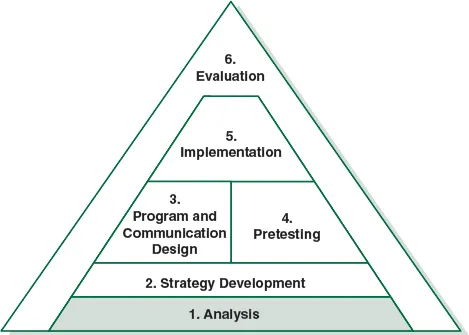
Hands-On Social Marketing
A Step-by-Step Guide to Designing Change for Good
- 328 pages
- English
- ePUB (mobile friendly)
- Available on iOS & Android
About this book
Six fail-proof steps to social marketing success!
This book shows students and practitioners how to develop social marketing programs through a simple, six-step process of strategic planning and design. Nedra Kline Weinreich starts by introducing the concept of social marketing and then walks the reader through each of the six steps of the process: analysis, strategy development, program and communication design, pretesting, implementation, and evaluation and feedback.
The Second Edition incorporates developments in marketing practice over the last 10 years and focuses on how to apply the design approach to campaigns to effect behavior change. All organizations can do social marketing, Weinreich insists, if they follow the steps and start to think from a social marketing perspective.
Frequently asked questions
- Essential is ideal for learners and professionals who enjoy exploring a wide range of subjects. Access the Essential Library with 800,000+ trusted titles and best-sellers across business, personal growth, and the humanities. Includes unlimited reading time and Standard Read Aloud voice.
- Complete: Perfect for advanced learners and researchers needing full, unrestricted access. Unlock 1.4M+ books across hundreds of subjects, including academic and specialized titles. The Complete Plan also includes advanced features like Premium Read Aloud and Research Assistant.
Please note we cannot support devices running on iOS 13 and Android 7 or earlier. Learn more about using the app.
Information
Section II
Step 1
SECTION OVERVIEW

- Chapter 5: Research in the Social Marketing Process
- Chapter 6: Analysis
- Chapter 7: Conducting Formative Research
CHAPTER 5
Research in the Social Marketing Process
- Formative research aids in the development of the strategy and includes the problem and environmental analysis, target audience research, and pretesting of messages and materials.
- Process evaluation research refers to the monitoring systems you put in place before and during implementation to track what is happening in the program and how people are responding in real time.
- Summative evaluation research helps you determine the effects of your program on reaching your goals and objectives, particularly in whether you brought about changes in factors such as knowledge, attitudes, and behaviors.
FORMATIVE RESEARCH
- What is the problem you are addressing?
- What is the context in which the problem exists?
- Who will be your target audience?
- How does your target audience think and behave as related to the problem?
- What product can you offer that will appeal to your target audience?
- What are the main barriers keeping your target audience from taking action?
- How can you best reach your target audience?
- Which messages and materials work best?
- What is the best social marketing mix?
PRIMARY AND SECONDARY RESEARCH
QUANTITATIVE AND QUALITATIVE RESEARCH
CHAPTER 6
Analysis
- The problem to be addressed
- The environment in which the program will be implemented
- Resources available for the program
ANALYZING THE PROBLEM
- Start with an Internet search to find freely available resources on your topic online.
- Have an idea of the type of information you need to learn about your issue, such as biological or psychosocial aspects, epidemiology, and previous interventions that have been attempted.
- You may be able to find excellent reports and articles, as well as data sets, that provide both broad and specific insights into your issue and audience.
- Try different variations of keywords in your search to help you find everything that might be out there. Include social media and news sites in your search as well.
- Follow links on the sites you find most useful to discover new sources of information that may not have shown up on your search.
- Search the academic databases for the most valid research in peer-reviewed journals.
- If you have access to a university library, you may be able to search its databases such as MEDLINE, PsychINFO, and POPLINE online or on site. You can also search Google Scholar for references to academic articles, books, and other publications.
- Once ...
Table of contents
- Cover Page
- Dedication
- Title Page
- Copyright
- Brief Contents
- Detailed Contents
- Foreword
- Preface
- SECTION I. WHAT IS SOCIAL MARKETING?
- SECTION II. STEP 1: ANALYSIS
- SECTION III. STEP 2: STRATEGY DEVELOPMENT
- SECTION IV. STEP 3: PROGRAM AND COMMUNICATION DESIGN
- SECTION V. STEP 4: PRETESTING
- SECTION VI. STEP 5: IMPLEMENTATION
- SECTION VII. STEP 6: EVALUATION AND FEEDBACK
- Appendix A. Social Marketing Resource List
- Appendix B. Sample Knowledge, Attitudes, and Behaviors Survey
- Appendix C. Sample Focus Group Recruitment Questionnaire
- Appendix D. Sample Focus Group Topic Guide
- Appendix E. Readability Testing Formula
- Index
- About the Author